Is it possible to water an orchid from above, care features, useful tips

The orchid (phalaenopsis) is loved for its large, colorful flowers that delight others for a long time. It is considered a fragile and whimsical plant. Few people associate the lack of flowering or death with improper watering. Flower owners are interested in: how to water an orchid correctly - from above or from below? Let's get acquainted with the basics of care.
Content:
- Basic principles of watering an orchid
- Subtleties of watering from above
- How to water an orchid from the shower
- Irrigation by immersion
- Useful tips for caring for your plant
Basic principles of watering
Having planted an exotic flower, the florist is faced with many questions during the growing process. Is it possible to water an orchid from above? Which pot to choose? What conditions are required? To make the plant comfortable, proper watering is necessary.

Frequency
For an orchid, it is difficult to determine how often it should be watered. It all depends on how intensely moisture evaporates from the soil in each specific case. The hotter the room and the drier the air, the more the flower needs liquid.
In a cool, damp room, reduce the number of waterings. Excess water can cause root rot. An excess of moisture has more negative consequences than a lack of it.
Temperature
Orchids do not like cold water. This slows down their growth. It is better to give preference to liquid at room temperature.
Compound
The ideal option is rainwater.This is the moisture the plant receives in its homeland. It is not always possible to obtain it. Therefore, it is better to consider other options.
If the tap water is very hard, you will have to eliminate it. It is harmful to the roots, has a lot of harmful impurities and adversely affects growth. Before use, raw water should be settled or filtered.
Frequently asked question: is it possible to water an orchid with boiled water? Experts agree that boiling perfectly gets rid of unnecessary impurities and bacteria. Plus, it's very easy to prepare.
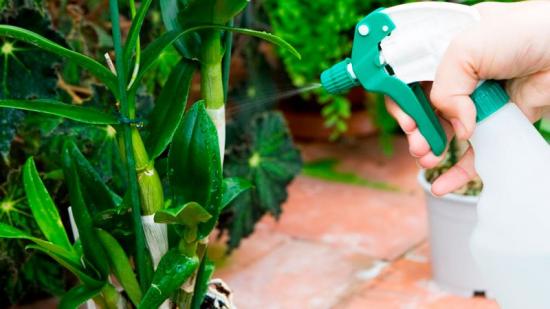
Pot
Choose a container with holes in the bottom. This will allow excess moisture to leave the pot. Excess dampness is dangerous for the roots. A thin layer (1-2 cm) of expanded clay is poured onto the bottom. The larger the volume of the pot, the longer it retains water.
In fact, the rules are not that difficult to follow. You need to properly organize your content from the very beginning.
Subtleties of watering from above
Watering orchids has some nuances. Beginning gardeners are faced with the question: is it possible to water orchids from above? The main thing to understand is that water should not get on the flowers and the top of the main shoot. Otherwise, rotting processes may start
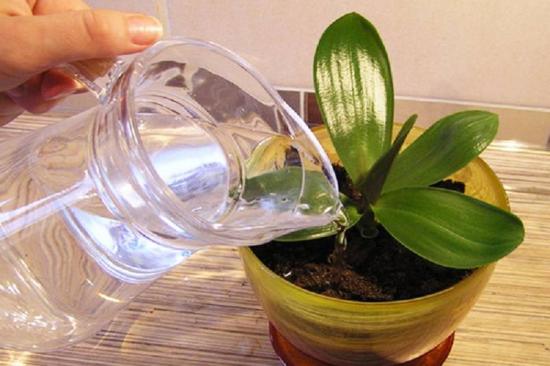
The same goes for spraying. If the air is too dry, the flower and the area around it are irrigated using a fine spray. Water should not flow onto the flower in a stream. The roots are the first to lose moisture. Therefore, it is better to spray this particular area.
The most common method of watering from above is using a watering can. The stream should be weak. It is worth choosing a watering can with a thin spout. We pass the area of the leaf axils. Water until moisture appears from the holes in the container at the bottom. Excess liquid is poured out of the pan.
Watering from above or spraying the roots is carried out in the first half of the day.
How to water an orchid from the shower
Watering from the shower is usually an auxiliary method of care. In addition to its main purpose, the method helps remove dust and dirt from leaves, facilitating gas exchange.
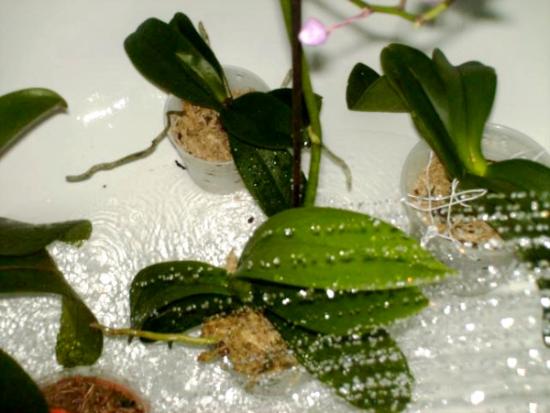
This is done as follows:
- place the flower pot in the bath
- turn on warm water (about 40 C)
- water the plant for a while
- leave the orchid in the same place for 15 minutes until excess water drains
- After an hour, remove moisture from the leaves with a paper towel or cotton cloth
It is useful to carry out the procedure 2-3 times a month. As a result, phalaenopsis will delight with more frequent and extensive flowering. Turn on a little pressure. Set the shower to diffuse mode.
Remove water from foliage after watering. If this procedure is neglected, the core may rot, the surface may become covered with salt deposits, or unaesthetic stains may form.
Is it possible to water an orchid while the buds are blooming? It is possible and necessary. A flowering plant needs watering even more. Remember to avoid getting flowers and buds wet.
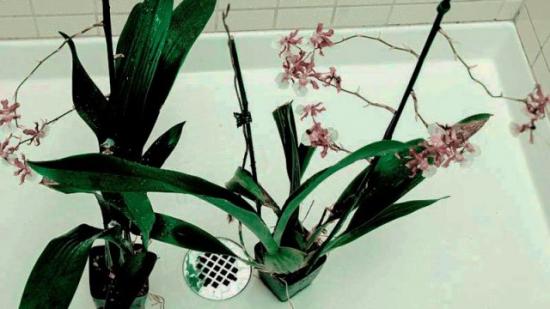
If you follow all the recommendations, watering from the shower has a beneficial effect on the flower. This is reminiscent of tropical rains occurring in natural conditions. The exception is when tap water is of very low quality. In such a situation, it will be more useful to choose another watering method.
Irrigation by immersion
Watering with this method is very effective and is used once a week.
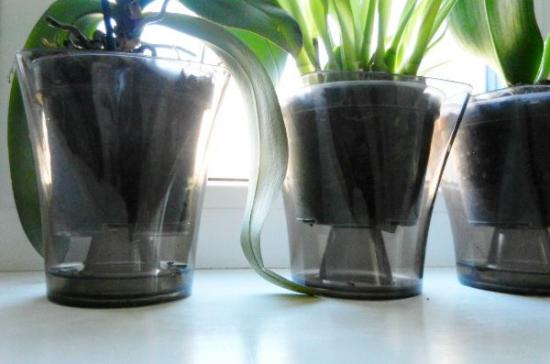
The procedure is carried out in several stages:
- Pour water (preferably filtered) into a container. You can add fertilizer for orchids.
- Immerse the flower pot so that the water does not touch the neck of the plant.
- Leave the orchid for 10-15 minutes.
- Let the excess moisture drain and put the pot in its original place.
In hot weather or when the air in the room is very dry, such watering can be done up to 3 times a week. Do not leave the flower in water for a long time (all day). So you risk getting swelling on the foliage due to oversaturation with liquid.
For watering by immersion, you can purchase a special pot. The diameter should exceed the diameter of the flowerpot, and choose a high bottom. It is convenient to place a flowerpot in a flowerpot and then water the flower. Or you can fill the container with water in advance, with a layer of about 2 cm. This way the flower will absorb as much moisture as it needs.
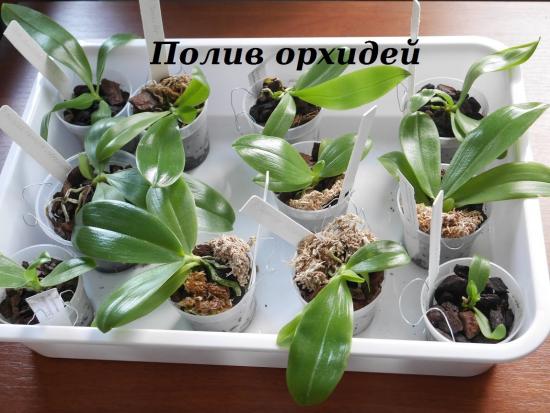
This is the most popular and safest method of watering. It is especially convenient to use it for owners of a large number of orchids.
Useful tips for caring for your plant
To prevent a tropical plant from dying and enjoying its flowering for a long time, you should try to create favorable conditions. Phalaenopsis has its own requirements for environmental parameters:
Orchids do not tolerate direct sunlight. In the tropics they are protected from ultraviolet radiation by lush vegetation. Diffused light is ideal.
Phalaenopsis loves moist air. Place a humidifier indoors or periodically mist the air around the plant. The higher the humidity, the better.
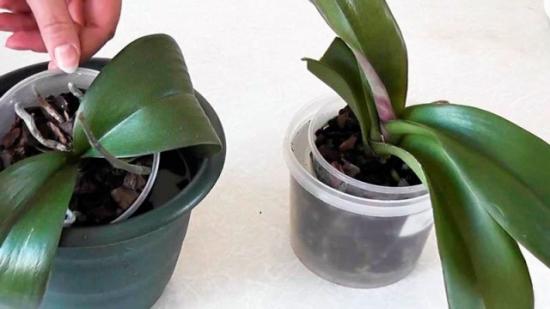
The most favorable temperature regime for a flower is around 23-24 C. The thermometer, even in winter, should not fall below 18 C. The permissible range is 18-27 C. At such temperatures the plant feels good.
In autumn, the orchid lays buds. During this period, she needs coolness (14-16 C) and shade. You can send the pot to the balcony, having previously taken care of shelter from light.
When the phalaenopsis fades, leave 3 vines (or 3 buds) below. The rest needs to be cut off. After flowering, the plant is given rest and moved to a darker place. It is advisable not to change the location after this.
Orchid is a capricious exotic plant. If there is a lack of water, it can sacrifice its flowers. However, with regard to phalaenopsis, the rule is the following: it is better to underfill than to overfill.
Excessive moisture is as destructive as drought. To enjoy flowering for a long time, it is necessary to observe moderation and follow the rules of watering.
For clarity, let’s watch a video about whether it is possible to water an orchid from above, as well as other optimal methods of watering a plant:






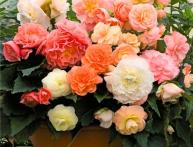
Comments
We have a phalaenopsis orchid growing at home. The pot is plastic, with holes not only at the bottom, but also along the walls. The pot is filled with tree bark. When watering, I pay attention to the leaves; if there are 4 of them, then I am watering correctly. If there are more leaves, then there is excess moisture; if there are fewer, then there is not enough moisture.
My mother waters all the flowers this way so that there are no spider mites, which often appear if the plant sits in the dust for a long time. All flowers must be sprayed, without exception.